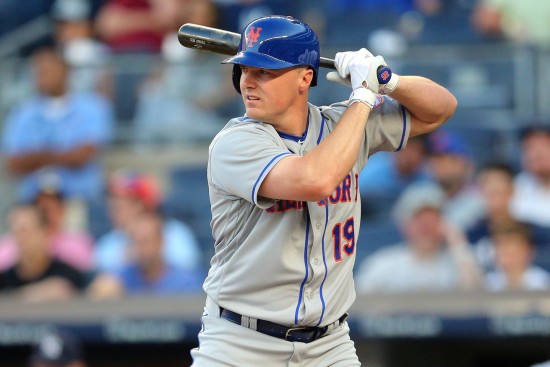
By now, you’ve heard the rumors from the winter meetings. Teams have proposed trades to Sandy Alderson for Jay Bruce but offering only fringe prospects and salary relief. Why is this? Are there really no good offers for a potential middle of the order 30 home run hitter?
Unfortunately, I think it’s time for many fans to understand that the potential for 30 home runs is all that Bruce brings to a club. And as he ages, a slightly slower swing does not translate well for an all or nothing hitter. Power hitters who strikeout a ton do not age well. You swing big, you miss big and as your bat speed goes away, the second result happens a lot more than the first.
Let’s review some of the reasons on why he was acquired in the first place and break them down on a deeper level to see if they hold any water.
He Was A Clutch Hitter
A common point of contention on why trading for Bruce was a good idea is that Bruce was hitting very well with runners in scoring position in 2016 while the Mets as a team suffered mightily in these situations. Bruce was indeed hitting very well, about .350 with RISP, 100 points higher than his career average. But did you really expect him to keep that up?
If Lucas Duda started off the first 3 months of 2017 hitting .350, do you expect him to continue that for a whole season or would you expect him to regress towards his career norm? If Curtis Granderson hits 25 HRs in the first 81 games of the season, do you expect him to finish with 50 at the end of the year?
If Bruce had always been much better in his career with RISP than in other situations, then this would be a legitimate point but his career batting average with and without RISP is right around .250 so the likelihood that his hitting in those situations continue at that pace was miniscule.
WAR Doesn’t Measure Bruce Accurately
Some people believe that since Bruce hits 30 home runs a year, he HAS to be a valuable player. The statistic of WAR or wins above replacement (the overall value of a player both on offense and defense) certainly disagrees.
While a major league average player averages 2-3 WAR per season, Bruce averaged 1.2 WAR in the 3 seasons leading up to 2016. Even with his “all-star” first half in 2016, he only produced a meager 1 WAR by season’s end. In layman’s terms, Jay Bruce is a below average starter and produces the value of a bench player.
Some fans look at this and state that WAR is a poor measurement of defense (this is relatively true) so WAR must be over-penalizing Bruce for his poor defense. How can we measure Bruce’s defensive liability in numbers that are familiar to us?
Why don’t we take a look at this from a different perspective? Let’s adjust Bruce’s player ratings and take some of his offensive value away to supplement his defensive rating to the point where he becomes a defensively average oufielder. What would his batting line look like in that case?
Over the course of a season, does Jay Bruce give up 25 more hits than your average defensive right fielder? This comes out to about one hit every 6 games. If he does, then let’s give him those 25 hits on defense and deduct them on offense. We can essentially take away 50 points from his batting line as 25 hits in 500 at bats is worth as much.
In this video game experiment, we traded a defensively poor Jay Bruce who hits .250/.300/.450 into a defensively average Jay Bruce who hits .200/.250/.400. With these statistics being a little more familiar, does this look like the slash line of an average major league outfielder to you now? The math behind this comparison isn’t perfect but it shows you why a 30 HR hitter can indeed be a below average player in the big leagues.
We Needed To Add A Bat
The Mets were struggling and fans were begging for a move. The truth is, we didn’t necessarily need a bat, we needed better production, preferably in the lineup. I won’t speculate about who else was available and at what price but internally on the Mets, Brandon Nimmo was barely given a shot before he was sent back down to Vegas.
Could Nimmo have produced better than 1 WAR in the second half of the year that you would optimistically hope for from Bruce (who produced 0 WAR in hindsight)? I would have taken my chances.
Bruce Was Leverage Against Cespedes
Stop this nonsense. A Toyota Corolla is not leverage against a Mercedes AMG. They don’t drink the same water and do not breathe the same air.
Look, I am not losing sleep over the package we gave for Bruce. However, I do find it frustrating that our offseason may be dependent on moving him. And in the case where Sandy does not find an offer to his liking, we may actually limit Michael Conforto’s playing time in order to play Bruce. This would be the biggest mistake of all.
Sandy is right about one thing. It only takes a couple of teams to be interested for him to get a good deal. If Sandy can indeed swing Bruce for something of value, then that will be another notch on his trade belt. However, it would also mean to me that the GM who does trade for Bruce overvalued him as well.













